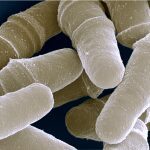Lien vers Pubmed [PMID] – 23118915
PLoS ONE 2012;7(10):e47987
Rad52 is a key player in homologous recombination (HR), a DNA repair pathway that is dedicated to double strand breaks repair and recovery of perturbed replication forks. Here we show that fission yeast Rad52 homologue is phosphorylated when S phase cells are exposed to ROS inducers such as ultraviolet A radiation or hydrogen peroxide, but not to ultraviolet C or camptothecin. Phosphorylation does not depend on kinases Chk1, Rad3, Tel1 or Cdc2, but depends on a functional stress activated protein kinase (SAPK) pathway and can be partially prevented by anti-oxidant treatment. Indeed, cells lacking Sty1, the major fission yeast MAP kinase of the SAPK pathway, do not display Rad52 phosphorylation and have UVA induced Rad52 foci that persist longer if compared to wild type cells. In addition, spontaneous intrachromosomal HR is diminished in cells lacking Sty1 and, more precisely, gene conversion is affected. Moreover, HR induced by site-specific arrest of replication forks is twice less efficient in cells that do not express Sty1. Importantly, impairing HR by deletion of the gene encoding the recombinase Rhp51 leads to Sty1 dependent Rad52 phosphorylation. Thus, SAPK pathway impinges on early step of HR through phosphorylation of Rad52 in cells challenged by oxidative stress or lacking Rhp51 and is required to promote spontaneous gene conversion and recovery from blocked replication forks.

